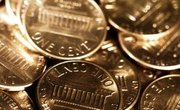
Science fair projects are a traditional rite of passage for elementary and middle school students. They allow students to explore the scientific method through developing and performing their own experiments. Determining which juice cleans pennies the best is a simple and straightforward science fair experiment for younger students. It allows students to pose a hypothesis, test the hypothesis and summarize their results. In addition, students can research possible explanations for their results for additional scientific discovery.
- Equally dirty pennies
- Several kinds of juice (apple, orange, lemon and pineapple, for example)
- Water
- Bowls for each kind of juice
- Paper towels
- Camera
- Notebook
- Posterboard
Scientists like to add positive and negative controls to an experiment, because it helps ensure the results are valid. A positive control is a treatment where you expect a large effect and a negative control is a treatment where you expect no change. For this experiment, you might expect water to be a negative control and something like muriatic acid to be the positive control. Do experiments with your control fluids right along with the experiments with your test juices.
If you do use an acid for the positive control, be sure to use protective equipment and perform the experiment in a well-ventilated area.
Pose your hypothesis. Guess which type of juice you think will clean pennies best, and write it down, along with why, in your notebook. You will probably want to use more than one type of juice.
Count out five dirty pennies. You will need one dirty penny for each type of juice.
Photograph each penny next to a label for the type of juice you will be soaking it in.
Submerge one penny each in the bowls filled with the individual juices. Soak for an hour.
Take each penny out and dry it with a paper towel. Photograph each penny next to its label and note which penny is cleanest.
Return the pennies to the same bowls of juice and water, and soak overnight.
Take the pennies out again. Dry and photograph the pennies next to their labels. Make notes on whether or not a longer soaking time got the pennies any cleaner, and if the same juice or a different juice cleaned the best depending on how long the penny soaked.
Summarize your results. Write down which juice cleaned a penny best, and whether or not it was the same juice that you had guessed. Whether your hypothesis was correct or incorrect, research cleaning strengths of juices in an encyclopedia or library to explain why.
Display your results. Print out pictures of the dirty and clean pennies and arrange them on the posterboard, along with captions explaining your hypothesis, the procedure you used to test your hypothesis and the results of the experiment.
